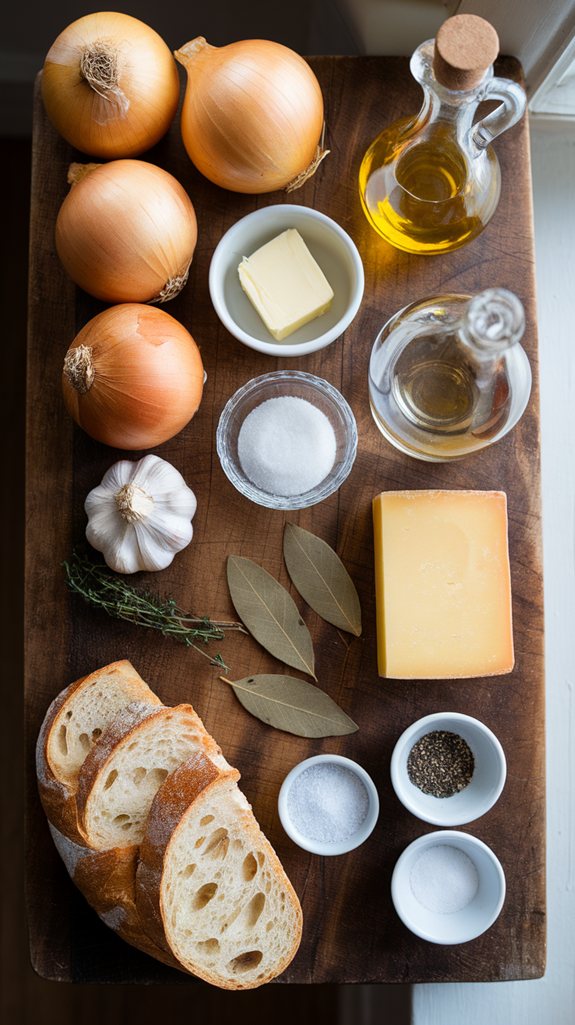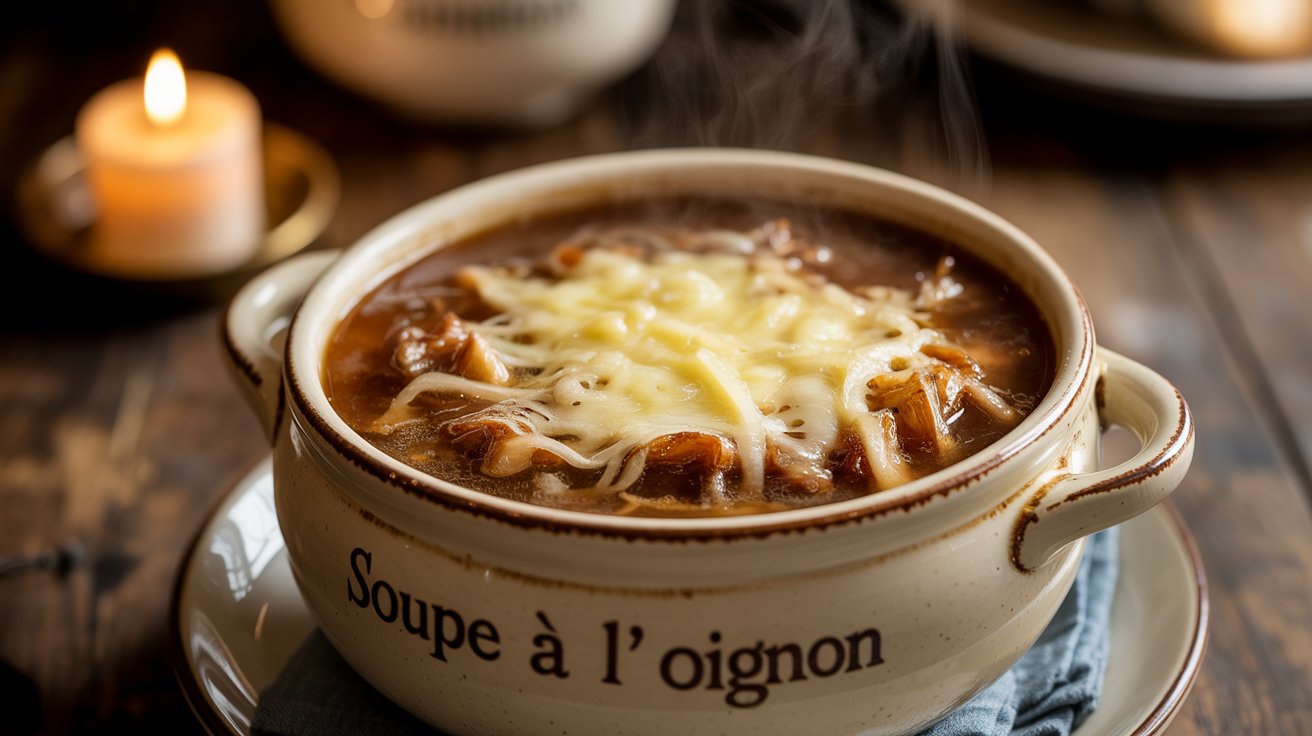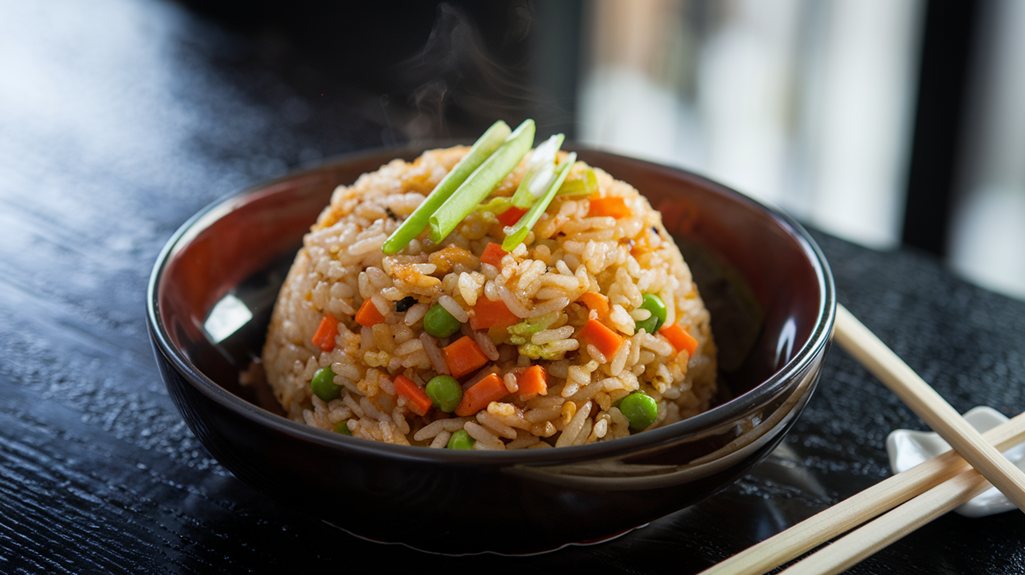You’ll uncover that Gordon Ramsay’s French onion soup isn’t just any winter comfort food – it’s a carefully crafted masterpiece with centuries of history behind it. From humble 8th-century beginnings to today’s refined techniques, this rich broth transforms simple onions into something extraordinary. While the basic ingredients haven’t changed much, Ramsay’s precise temperature control and expert timing create layers of flavor that’ll make you wonder what other secrets this classic dish holds.
8th-Century French Classic
While French onion soup‘s exact origins remain somewhat unclear, this hearty dish emerged as a staple of French cuisine during the 18th century.
Originally created as a humble peasant meal using simple, available ingredients, it’s now one of the most beloved classic soups worldwide.
You’ll find Gordon Ramsay’s recipe raises this traditional dish to new heights, while staying true to its rustic roots.
His version combines perfectly caramelized onions with rich beef stock and a blend of complementary seasonings.
When you’re making this soup, you’ll notice how the slow cooking process transforms ordinary onions into sweet, golden strands that create the soup’s signature depth.
The delicate balance of flavors mirrors his approach to pan seared scallops where each element must be perfectly executed.
The finishing touch of crusty bread and melted cheese makes this French onion soup a timeless comfort food that’s just as at home in casual kitchens and fine restaurants.
Like his famous Beef Wellington recipe, this dish demonstrates Ramsay’s commitment to elevating classic dishes with precise technique and attention to detail.
Similar to his approach with roast chicken stuffing, Ramsay emphasizes the importance of quality ingredients and proper seasoning in creating memorable dishes.
Peasant Soup Origins

French onion soup’s humble beginnings can be traced back to the working-class kitchens of 18th century Paris. Originally a peasant dish, it was created as a way to make the most of simple, readily available ingredients like onions, stale bread, and basic broths, transforming these modest components into a deeply satisfying meal.
The genius of this peasant soup lies in its technique of slow-cooking onions until they develop a rich, caramel sweetness, then combining them with savory broth and crusty bread. This method of preparation demonstrates how peasant ingenuity could transform ordinary ingredients into extraordinary flavors, creating a dish that would eventually become a celebrated classic of French cuisine. Like the Arborio rice used in risotto, selecting the right ingredients is crucial for achieving the perfect texture and flavor.
- 6 large yellow onions, thinly sliced
- 4 tablespoons butter
- 2 tablespoons olive oil
- 1 teaspoon sugar
- 2 cloves garlic, minced
- 8 cups beef stock
- 1/2 cup dry white wine
- 2 bay leaves
- 4 sprigs fresh thyme
- Salt and black pepper to taste
- 6 slices day-old baguette
- 2 cups grated Gruyère cheese
Begin by melting butter with olive oil in a large pot over medium heat. Add sliced onions and sugar, cooking for about 45 minutes until deeply caramelized, stirring occasionally.
Add garlic and cook for another minute, then pour in the wine and scrape up any browned bits from the bottom. Add beef stock, bay leaves, and thyme, bringing to a simmer. Reduce heat and cook for 30 minutes, then season with salt and pepper.
To serve, ladle soup into oven-safe bowls, top with bread slices and cheese, then broil until the cheese is golden and bubbly.
For best results, use yellow onions as they contain the perfect balance of sugar and aromatics for caramelization. Patience is vital during the caramelization process – rushing this step will result in bitter rather than sweet onions.
The bread should be slightly stale to better absorb the broth without falling apart, and while Gruyère is traditional, a combination of Swiss and Parmesan cheese can work as a substitute.
Similar to risotto preparation, continuous stirring helps develop rich, complex flavors in this classic French soup.
Regional French Broth Styles
Three distinct regional styles of onion soup broth have emerged across France’s culinary landscape.
In the north, you’ll find a lighter, more delicate broth that’s made with chicken stock and white wine, creating one of the most refined savory soups in French cuisine.
The central regions prefer rich broths featuring beef stock and cognac, which you’ll recognize in most classic french soup recipes today.
Southern French variations often incorporate tomatoes and herbs like thyme and sage, making their broths slightly more rustic and aromatic.
Each region’s unique interpretation reflects local ingredients and traditions, though they all share the fundamental technique of properly caramelizing onions to develop deep, complex flavors that make this dish so beloved throughout France.
Key Temperature Control Points
Maintaining precise temperature control throughout the cooking process proves essential for achieving perfectly caramelized onions and a well-balanced French onion soup.
You’ll want to start with medium heat when sautéing your onions, keeping them around 325°F to prevent burning. Once they’re soft, increase the temperature to medium-high, about 375°F, to achieve that golden-brown caramelization.
When you add the beef broth and thyme, reduce the heat to a gentle simmer at 185-195°F. You’ll notice small bubbles breaking the surface, which is exactly what you want. At this temperature, the onions will continue to soften and release their sweetness into the broth.
For the final broiling step with cheese on top, set your oven to 450°F for that perfect golden crust.
Cool Storage Tips
Proper storage techniques can make a significant difference in preserving your French onion soup’s rich flavors and textures.
After you’ve learned how to make French onion soup, you’ll want to store any leftovers correctly to enjoy later. Let your soup cool completely before transferring it to airtight containers, leaving a bit of space at the top for expansion.
For refrigeration, you can keep your hearty soups fresh for up to 4 days. If you’ve topped your soup with gruyere cheese, store it separately to maintain the best texture.
For longer storage, ladle the cooled soup into freezer-safe containers or bags, removing as much air as possible. Your soup will keep well in the freezer for up to 3 months – just remember to label containers with the date.
Onion-Crusted Bowl Edges
Creating perfectly crusted bowl edges adds an irresistible texture to your French onion soup presentation.
To achieve this gourmet French dish finish, you’ll want to ladle your rich and hearty soup into oven-safe bowls, letting some broth splash slightly over the edges.
Place your cheese mixture of Gruyere and Parmesan around the bowl’s rim, pressing gently to help it stick.
When you broil the soup, the cheese will melt and create a beautiful crust that extends beyond the bowl’s edge.
Watch carefully as the cheese browns and bubbles, usually taking 3-4 minutes.
You’ll know it’s ready when you see a golden-brown ring forming around the edge, creating that restaurant-style appearance that’ll impress your guests.







